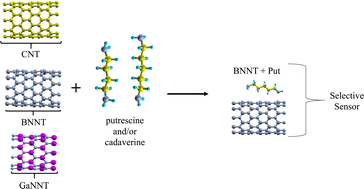Detection of cadaverine and putrescine on (10,0) carbon, boron nitride and gallium nitride nanotubes: a density functional theory study
Abstract
This work presents a theoretical study of the interaction between carbon nanotubes (CNTs), boron nitride nanotubes (BNNTs) and gallium nitride nanotubes (GaNNTs) with the pollutant diamines cadaverine and putrescine, using density functional theory (DFT) as implemented using SIESTA. For this purpose, we analyzed the structural, energetic and electronic properties of (10,0) nanotubes with cadaverine and putrescine adsorbed, respectively, on their external surfaces. From the results, two important conclusions were inferred: (i) the CNTs and BNNTs interacted with both molecules through a moderate adsorption process, making spontaneous desorption not so difficult; (ii) the GaNNTs interacted very strongly with both molecules through a chemical adsorption process, which makes the desorption process difficult. Overall, our results are promising for the use of BNNTs in environmental applications, such as pollutant sensors for detecting selectively cadaverine in the presence of putrescine molecules.



 Please wait while we load your content...
Please wait while we load your content...